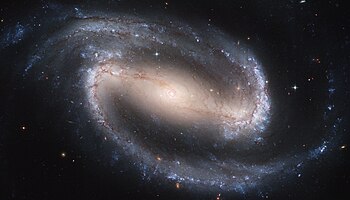
A barred spiral galaxy is a spiral galaxy with a central bar-shaped structure composed of stars.[1] Bars are found in about two thirds of all spiral galaxies in the local universe,[2] and generally affect both the motions of stars and interstellar gas within spiral galaxies and can affect spiral arms as well.[3][4] The Milky Way Galaxy, where the Solar System is located, is classified as a barred spiral galaxy.[5]
Edwin Hubble classified spiral galaxies of this type as "SB" (spiral, barred) in his Hubble sequence and arranged them into sub-categories based on how open the arms of the spiral are. SBa types feature tightly bound arms, while SBc types are at the other extreme and have loosely bound arms. SBb-type galaxies lie in between the two. SB0 is a barred lenticular galaxy. A new type, SBm, was subsequently created to describe somewhat irregular barred spirals, such as the Magellanic Clouds, which were once classified as irregular galaxies, but have since been found to contain barred spiral structures. Among other types in Hubble's classifications for the galaxies are the spiral galaxy, elliptical galaxy and irregular galaxy.
Although theoretical models of galaxy formation and evolution had not previously expected galaxies becoming stable enough to host bars very early in the universe's history, evidence has recently emerged of the existence of numerous spiral galaxies in the early universe.[6][7][8]

- ^ "Barred spiral galaxy". ScienceDaily. Retrieved 2018-09-17.
- ^ Cite error: The named reference
eskridgewas invoked but never defined (see the help page). - ^ Mihalas, D. (1968). Galactic Astronomy. W. H. Freeman. ISBN 978-0-7167-0326-6.
- ^ Ferris, Timothy (1998). The Whole Shebang: A State-of-the-Universe(s) Report. Simon & Schuster. ISBN 978-0-6848-3861-8.
- ^ Gerhard, Ortwin (2002). "Mass distribution in our Galaxy". Space Science Reviews. 100: 129. arXiv:astro-ph/0203110. Bibcode:2002SSRv..100..129G. doi:10.1023/A:1015818111633. S2CID 42162871.
- ^ Milky Way-like galaxy found in the early universe
- ^ Costantin, Luca; Pérez-González, Pablo G.; Guo, Yuchen; Buttitta, Chiara; Jogee, Shardha; Bagley, Micaela B.; Barro, Guillermo; Kartaltepe, Jeyhan S.; Koekemoer, Anton M.; Cabello, Cristina; Corsini, Enrico Maria; Méndez-Abreu, Jairo; de la Vega, Alexander; Iyer, Kartheik G.; Bisigello, Laura (2023). "A Milky Way-like barred spiral galaxy at a redshift of 3". Nature. 623 (7987): 499–501. arXiv:2311.04283. Bibcode:2023Natur.623..499C. doi:10.1038/s41586-023-06636-x. ISSN 1476-4687. PMC 10651483. PMID 37938777.
- ^ Guo, Yuchen; Jogee, Shardha; Finkelstein, Steven L.; Chen, Zilei; Wise, Eden; Bagley, Micaela B.; Barro, Guillermo; Wuyts, Stijn; Kocevski, Dale D.; Kartaltepe, Jeyhan S.; McGrath, Elizabeth J.; Ferguson, Henry C.; Mobasher, Bahram; Giavalisco, Mauro; Lucas, Ray A. (2023-03-01). "First Look at z > 1 Bars in the Rest-frame Near-infrared with JWST Early CEERS Imaging". The Astrophysical Journal Letters. 945 (1): L10. arXiv:2210.08658. Bibcode:2023ApJ...945L..10G. doi:10.3847/2041-8213/acacfb. ISSN 2041-8205.
- ^ "A closer look at IC 5201". www.spacetelescope.org. Archived from the original on 15 December 2016. Retrieved 12 December 2016.